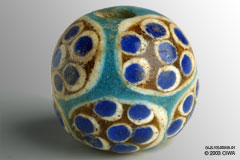Compound eye bead, 400-300 BC

Links to other views:⇒ Larger Viewif scripting is off, click the ⇒ instead. Links to others of type BeadApophis coils bead, EgyptBead with zigzag trail and threadhole collars Bead with zigzag trail and threadhole collars Bead with zigzag trail and threadhole collars Biconical millefiori mosaic bead Checkerboard mosaic bead, Roman period Checkerboard mosaic bead, Roman period Chevron glass bead, Venice Compound eye bead, 550-300 BC Compound eye bead with prunts, 400-300 BC Cylindrical chevron bead, Venice Face bead of undetermined origin Four-layer stratified eye bead, 400-300 BC Fustat mosaic bead, 800-1000 AD Head bead with eyes and prunts, 500-300 BC Hellenistic ribbon bead, 200 BC-100 AD Large eye bead with trails, 630-1400 AD Massive chevron bead, Venice Massive trail decorated bead Millefiori mosaic glass bead Millefiori mosaic glass bead Mirror decoration bead, 1000-1200 AD Mirror decoration bead, 900-1200 AD Mosaic bead with four faces, 1-100 AD Mosaic bead with three faces, 1-100 AD Mosaic eye bead, Roman period Mosaic eye bead, Roman period Necklace with beads and seven amulets Paired stratified eye bead, 600-300 BC Pentagonal millefiori glass bead Square glass bead with tricolor zigzag Stratified horned eye bead, 500-200 BC Three-plus-four eye bead, 600-400 BC Trail decorated glass bead Trail-decorated bead, 30 BC-400 AD Trail-decorated bead, 332-30 BC Trail-decorated glass bead Trailed eye bead Trailed eye bead Trailed eye bead Two-layer stratified eye bead, 500-200 BC Two-layer stratified eye bead, 500-200 BC Two-layer stratified eye bead, 500-200 BC Two-layer stratified eye bead, 500-200 BC Two-layer stratified eye bead, 500-200 BC |
This compound eye bead presents seven compounds eyes in the classic ‘three plus four’ arrangement in which three eyes are arranged around the bead on one side of the ‘equator’, and four slightly smaller eyes are arranged on the other side of the ‘equator’. Each of the seven compound eyes itself comprises seven layered eyes. These inner eyes were fashioned with a violet blue center over opaque white, and placed on a translucent brown background bordered with white. This decoration was applied over a base bead of translucent aquamarine glass formed on a rod into a compressed sphere. Spaer (2001:93) believes that compound eyes of this type were added as a premanufactured unit. This type of bead is usually found in fourth century BC contexts, in the eastern Mediterranean, and may have been made in Egypt. “Compound eye-beads are usually opaque bright blue or green, rarely dark blue and they are frequently decorated with seven compound eyes, each composed of a brown layer filled with seven tiny eyes” (Stern and Schlick-Nolte 1994:198#41). Parallels: Israel Museum #89.35.4 “Compound eye bead, Mediterranean region (Egypt?), 4th. century BC. (Spaer 2001:93, #105). Eye Beads Beads ornamented with spots or other circular designs that we believe represented eyes represent a very large proportion of all beads made in antiquity. Spaer (2001:77) writes: “The earliest glass eye beads were. . . a spot on a contrasting ground, or a spot with contrasting rings. This ‘spot and ring’ design—occasionally a spot alone—made in glass and added to a basic glass bead eventually became the standard type of glass eye bead. The eye symbol has always played an important role in magic beliefs and practices. Eye beads were commonly seen as apotropaic [apotropaic: having the power to prevent evil or bad luck], their primary function being that of protecting against the ‘Evil Eye.’. . . Seen from a more general perspective, the Evil Eye concept can be regarded as symbolizing the fears and anxieties we all face. It is indeed encountered in diverse cultures and periods of time. . . Even so, there may have been instances in which eye beads were appreciated more for their decorative value. Any symbol in use for a long time is likely to become part of convention and tradition and lose some of its magical application in the process.” The earliest types of eye beads (first half of the 1st millennium BC) were made by applying a trail from a molten rod of glass of a contrasting color onto a base bead—essentially drawing circles on the surface of the bead. Around the 7th century BC, the stratified technique became most common, where the craftsman made the eye and its ring by applying pre-made disks of decreasing size on top of each other. A broken stratified eye bead shows all these layers (or ‘strata’) in cross-section. Stratified eyes can be made in several manners. The layers can be built right on the bead, first applying the outer ring, then a middle ring, then the center of the eye. This is very difficult because one is working with hot, softened glass and shapes are difficult to maintain. Alternately, the whole stratified eye could be pre-made, then applied onto the base bead, which presumably provided more control. The eye could be pre-made face up, or face down, letting the softened ring disks sag around the inner layers. Eventually, craftsmen premanufactured whole strips of several eyes that were inserted as a row on the base bead. During the 3rd century a faster eye forming method gained the favor of the more technologically advanced workshop: the mosaic eye. Once a shop had the know-how to manufacture stocks of mosaic cane with concentric circles, it was much faster to insert a slice of that mosaic cane into a base bead than to manufacture eyes individually. Not all shops were able to produce mosaic cane (or purchase pre-made mosaic cane) from others, and so both techniques remained in use. Bibliography (for this item)Spaer, Maud2001 Ancient glass in the Israel Museum: beads and other small objects. The Israel Museum, Jerusalem. (93 #105) Stern, E. Marianne, and Birgit Schlick-Nolte 1994 Early Glass of the Ancient World 1600 BC - AD 50 Ernesto Wolf Collection. Gerd Hatje, Ostfildern, Germany. (198 # 41) Bibliography (on Eye Beads)Spaer, Maud2001 Ancient glass in the Israel Museum: beads and other small objects. The Israel Museum, Jerusalem. |